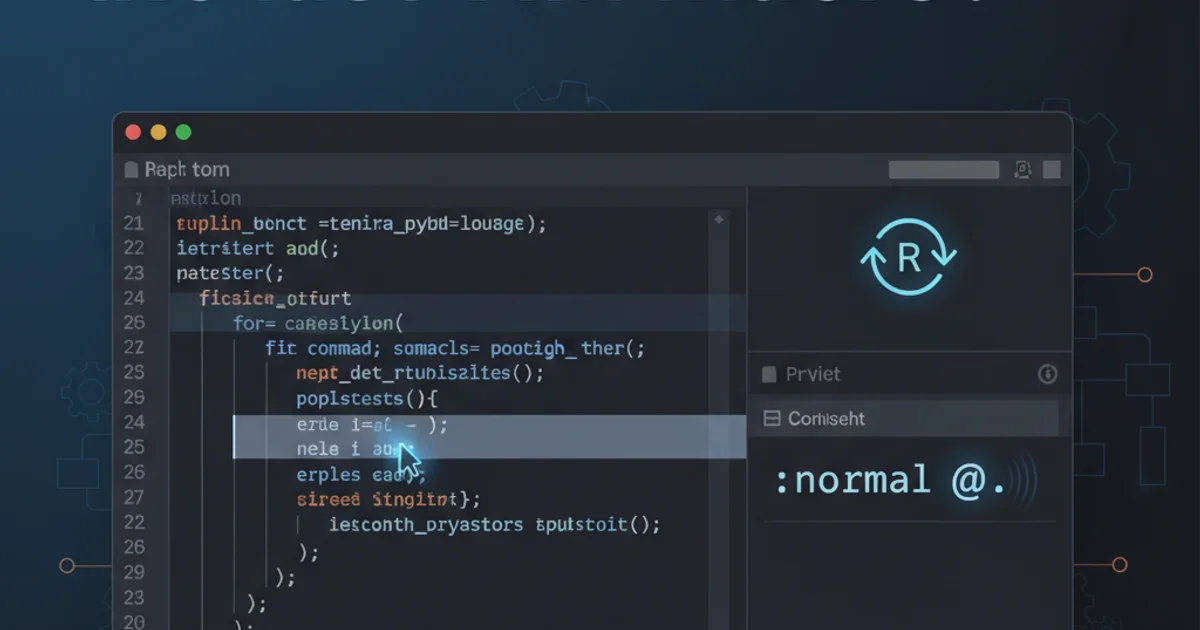How can I repeat the last VIM macro?
Categories:
Mastering Vim Macros: Repeating Your Last Recording

Learn how to efficiently repeat your last recorded Vim macro, saving time and boosting your editing productivity.
Vim macros are a powerful feature that allows you to record a sequence of keystrokes and then replay them. This is incredibly useful for automating repetitive tasks. While recording a macro is straightforward, knowing how to quickly and repeatedly execute the last recorded macro is key to unlocking its full potential. This article will guide you through the essential commands and techniques for repeating your most recent Vim macro.
The Basics: Recording and Playing a Macro
Before we dive into repeating the last macro, let's quickly review how to record and play a macro in Vim. A macro is recorded into a register, typically a letter from a to z. The process involves starting the recording, performing your actions, and then stopping the recording.
qa " Start recording into register 'a'
<actions> " Perform your desired keystrokes
q " Stop recording
Recording a macro into register 'a'
Once recorded, you can play the macro using the @ command followed by the register name. For example, to play the macro stored in register a:
@a " Play the macro from register 'a'
Playing a macro from register 'a'
Repeating the Last Macro: The @@ Command
Vim provides a special command, @@, specifically designed to repeat the last executed macro. This is incredibly convenient because you don't need to remember which register you used for your most recent macro. As soon as you've played a macro once (e.g., @a), you can use @@ to play it again, and again, and again.
qa " Record macro into 'a'
<actions>
q
@a " Execute macro 'a' for the first time
@@ " Execute the *last* macro again (which was 'a')
@@ " Execute it again
5@@ " Execute the last macro 5 more times
Using @@ to repeat the last executed macro
@@ command is context-aware. It will always repeat the very last macro you executed, regardless of whether it was played from a named register (@a) or the unnamed register (@).Understanding the Macro Execution Flow
To better visualize how macros are recorded and then repeatedly executed, consider the following flow. This diagram illustrates the lifecycle from recording to the repeated execution of a macro.
flowchart TD
A[Start Recording (q<register>)] --> B{Perform Actions}
B --> C[Stop Recording (q)]
C --> D[Execute Macro First Time (@<register>)]
D --> E["Last Macro" Register Updated]
E --> F[Repeat Last Macro (@@)]
F --> G{Need to Repeat Again?}
G -- Yes --> F
G -- No --> H[End]Flowchart of Vim Macro Recording and Repetition
Practical Application: Repeating a Macro with a Count
One of the most powerful aspects of @@ is its ability to be combined with a numerical prefix. This allows you to execute the last macro a specific number of times without having to type @@ repeatedly. This is a massive time-saver for tasks like adding a prefix to multiple lines, reformatting a block of code, or deleting specific patterns.
qaI// <Esc>q " Macro to prepend '// ' to a line
@a " Apply to current line
10@@ " Apply to the next 10 lines
Applying a macro to multiple lines using a count
1. Record Your Macro
Press q followed by a register name (e.g., a) to start recording. Perform your desired actions, then press q again to stop.
2. Execute Macro Once
Press @ followed by the register name (e.g., @a) to execute the macro for the first time. This sets the 'last executed macro' for @@.
3. Repeat the Last Macro
To repeat the macro, simply press @@. For multiple repetitions, use a count prefix, e.g., 5@@ to repeat it five times.